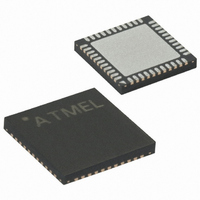ATMEGA324P-A15MZ Atmel, ATMEGA324P-A15MZ Datasheet - Page 172

ATMEGA324P-A15MZ
Manufacturer Part Number
ATMEGA324P-A15MZ
Description
MCU AVR 32KB FLASH 15MHZ 44-VQFN
Manufacturer
Atmel
Series
AVR® ATmegar
Datasheet
1.ATMEGA324P-A15MZ.pdf
(346 pages)
Specifications of ATMEGA324P-A15MZ
Package / Case
44-VQFN Exposed Pad
Voltage - Supply (vcc/vdd)
2.7 V ~ 5.5 V
Operating Temperature
-40°C ~ 125°C
Speed
16MHz
Number Of I /o
32
Eeprom Size
1K x 8
Core Processor
AVR
Program Memory Type
FLASH
Ram Size
2K x 8
Program Memory Size
32KB (32K x 8)
Data Converters
A/D 8x10b
Oscillator Type
Internal
Peripherals
Brown-out Detect/Reset, POR, PWM, WDT
Connectivity
I²C, SPI, UART/USART
Core Size
8-Bit
Lead Free Status / RoHS Status
Lead free / RoHS Compliant
- Current page: 172 of 346
- Download datasheet (3Mb)
Combining Address
and Data Packets into
a Transmission
Multi-master Bus
Systems,
Arbitration and
Synchronization
172
ATmega32(L)
Figure 80. Data Packet Format
A transmission basically consists of a START condition, a SLA+R/W, one or more data packets
and a STOP condition. An empty message, consisting of a START followed by a STOP condi-
tion, is illegal. Note that the wired-ANDing of the SCL line can be used to implement
handshaking between the master and the slave. The slave can extend the SCL low period by
pulling the SCL line low. This is useful if the clock speed set up by the master is too fast for the
slave, or the slave needs extra time for processing between the data transmissions. The slave
extending the SCL low period will not affect the SCL high period, which is determined by the
master. As a consequence, the slave can reduce the TWI data transfer speed by prolonging the
SCL duty cycle.
Figure 81
between the SLA+R/W and the STOP condition, depending on the software protocol imple-
mented by the application software.
Figure 81. Typical Data Transmission
The TWI protocol allows bus systems with several masters. Special concerns have been taken
in order to ensure that transmissions will proceed as normal, even if two or more masters initiate
a transmission at the same time. Two problems arise in multi-master systems:
•
•
The wired-ANDing of the bus lines is used to solve both these problems. The serial clocks from
all masters will be wired-ANDed, yielding a combined clock with a high period equal to the one
An algorithm must be implemented allowing only one of the masters to complete the
transmission. All other masters should cease transmission when they discover that they
have lost the selection process. This selection process is called arbitration. When a
contending master discovers that it has lost the arbitration process, it should immediately
switch to slave mode to check whether it is being addressed by the winning master. The fact
that multiple masters have started transmission at the same time should not be detectable to
the slaves, i.e., the data being transferred on the bus must not be corrupted.
Different masters may use different SCL frequencies. A scheme must be devised to
synchronize the serial clocks from all masters, in order to let the transmission proceed in a
lockstep fashion. This will facilitate the arbitration process.
SDA
SCL
Transmitter
Aggregate
SDA from
SDA from
SCL from
receiverR
Master
SDA
START
SLA+R/W
shows a typical data transmission. Note that several data bytes can be transmitted
Addr MSB
1
2
Data MSB
SLA+R/W
1
Addr LSB
7
R/W
2
8
ACK
9
Data Byte
7
Data MSB
Data LSB
1
8
2
Data Byte
ACK
9
7
Data LSB
8
STOP, REPEATED
ACK
9
START or Next
Data Byte
2503N–AVR–06/08
STOP
Related parts for ATMEGA324P-A15MZ
Image
Part Number
Description
Manufacturer
Datasheet
Request
R

Part Number:
Description:
Manufacturer:
Atmel Corporation
Datasheet:

Part Number:
Description:
Manufacturer:
Atmel Corporation
Datasheet:

Part Number:
Description:
IC MCU AVR 32K FLASH 44-TQFP
Manufacturer:
Atmel
Datasheet:

Part Number:
Description:
IC MCU AVR 32K FLASH 44-QFN
Manufacturer:
Atmel
Datasheet:

Part Number:
Description:
IC MCU AVR 32K FLASH 40-DIP
Manufacturer:
Atmel
Datasheet:

Part Number:
Description:
MCU AVR 32K FLASH 20MHZ 44-QFN
Manufacturer:
Atmel
Datasheet:

Part Number:
Description:
MCU AVR 32KB FLASH 20MHZ 44TQFP
Manufacturer:
Atmel
Datasheet:

Part Number:
Description:
MCU AVR 32KB FLASH 20MHZ 44QFN
Manufacturer:
Atmel
Datasheet:

Part Number:
Description:
MCU AVR 32KB FLASH 20MHZ 44TQFP
Manufacturer:
Atmel
Datasheet:

Part Number:
Description:
MCU AVR 32K FLASH 20MHZ 44-QFN
Manufacturer:
Atmel
Datasheet:

Part Number:
Description:
MCU AVR 32K FLASH 15MHZ 44-TQFP
Manufacturer:
Atmel
Datasheet:










